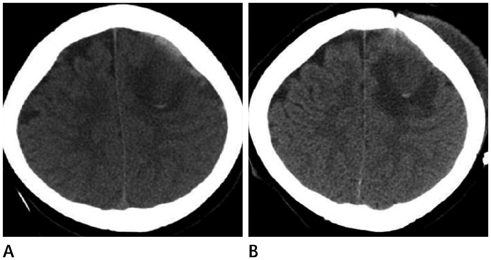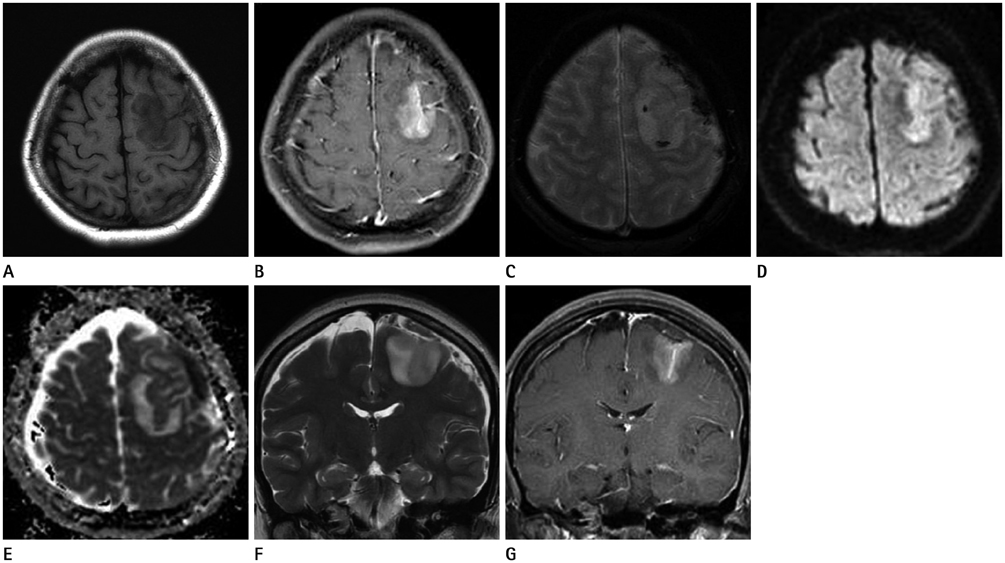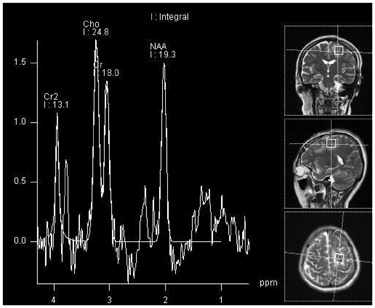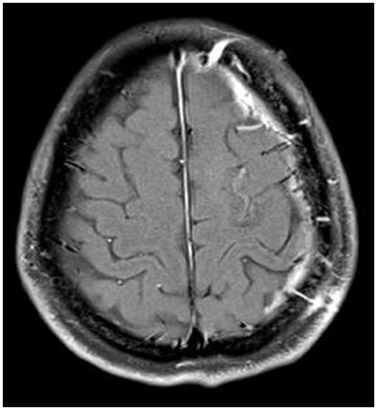J Korean Soc Radiol.
2014 Oct;71(4):155-159. 10.3348/jksr.2014.71.4.155.
Post-Traumatic Contrast Enhancing Brain Lesion
- Affiliations
-
- 1Department of Radiology, Eulji Hospital, Eulji University College of Medicine, Seoul, Korea. khs46359@eulji.ac.kr
- 2Department of Neurosurgery, Eulji Hospital, Eulji University College of Medicine, Seoul, Korea.
- KMID: 2097997
- DOI: http://doi.org/10.3348/jksr.2014.71.4.155
Abstract
- Only a few studies have been reported on the MR contrast enhancement and the apparent diffusion coefficient (ADC) findings of the post-traumatic lesion of the brain. We report a case of the venous ischemia in the left frontal lobe observed in the MRI obtained one day after the incidence of trauma. Considering the presented slight increase in the ADC, the vasogenic edema was thought to be the major mechanism of the venous ischemia and excitotoxic injury. In spite of a slight increase in the ADC, the hyperintensity in the diffusion weighted imaging and contrast-enhanced areas eventually changed into hemorrhagic lesions.
Figure
Reference
-
1. Matsushige T, Nakaoka M, Kiya K, Takeda T, Kurisu K. Cerebral sinovenous thrombosis after closed head injury. J Trauma. 2009; 66:1599–1604.2. Forbes KP, Pipe JG, Heiserman JE. Evidence for cytotoxic edema in the pathogenesis of cerebral venous infarction. AJNR Am J Neuroradiol. 2001; 22:450–455.3. Osborn AG. Osborn's barin: imaging, pathology and anatomy. Salt Lake City: Amirsys;2013. p. 1–72.4. Stam J. Thrombosis of the cerebral veins and sinuses. N Engl J Med. 2005; 352:1791–1798.5. Saposnik G, Barinagarrementeria F, Brown RD Jr, Bushnell CD, Cucchiara B, Cushman M, et al. Diagnosis and management of cerebral venous thrombosis: a statement for healthcare professionals from the American Heart Association/American Stroke Association. Stroke. 2011; 42:1158–1192.6. Alahmadi H, Vachhrajani S, Cusimano MD. The natural history of brain contusion: an analysis of radiological and clinical progression. J Neurosurg. 2010; 112:1139–1145.7. Armin SS, Colohan AR, Zhang JH. Vasospasm in traumatic brain injury. Acta Neurochir Suppl. 2008; 104:421–425.8. Shahlaie K, Keachie K, Hutchins IM, Rudisill N, Madden LK, Smith KA, et al. Risk factors for posttraumatic vasospasm. J Neurosurg. 2011; 115:602–611.9. Kim JH, Chang KH, Na DG, Song IC, Kwon BJ, Han MH, et al. 3T 1H-MR spectroscopy in grading of cerebral gliomas: comparison of short and intermediate echo time sequences. AJNR Am J Neuroradiol. 2006; 27:1412–1418.10. Leach JL, Fortuna RB, Jones BV, Gaskill-Shipley MF. Imaging of cerebral venous thrombosis: current techniques, spectrum of findings, and diagnostic pitfalls. Radiographics. 2006; 26:Suppl 1. S19–S41. discussion S42-S43.
- Full Text Links
- Actions
-
Cited
- CITED
-
- Close
- Share
- Similar articles
-
- Delirium After Traumatic Brain Injury: Prediction by Location and Size of Brain Lesion
- Two Cases of Traumatic Pericallosal Artery Aneurysm: A Case Report
- T1-weighted FLAIR MR Imaging for the Evaluation of Enhancing Brain Tumors: Comparison with Spin Echo Imaging
- Comparison of MR Imaging Findings Between Post-operative Change and Residual/Recurrent Tumor in Cerebral Glioma
- Contrast-Enhanced Turbo Spin-Echo(TSE) T1-weighted Imaging: Improved Contrast of Enhancing Lesions





